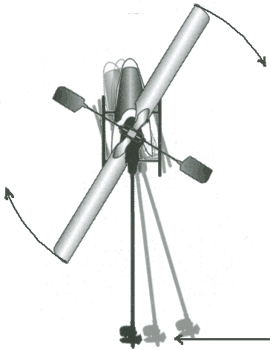The single-rotor RC helicopter is the most like a full size, person-carrying helicopter. It is faster and more maneuverable than a co-axial heli. At higher speeds the rotor disk behaves a lot like an airplane's wing.

Single rotor helicopters use a tail rotor to stop the body from turning in the opposite direction from the rotation of the main rotor blades. Although this mechanism opens the door to speed, power, and maneuverability, it takes more skill to fly. RC pilots who can fly a co-axial heli well are often surprised to discover how different a single rotor helicopter is. (RC heli's offer endless challenges, remember?)
Single rotor heli's have features that distinguish them as types within this category. Basic models' main rotor blade's angle does not change. They are said to have fixed pitch, (FP). More advanced models do change the angle of the main blades. This ability is called 'collective pitch' (CP). FP heli's cost less and are slower than CP birds. FP heli's react more slowly to the controls, which gives new pilots time to figure out how to fly. CP heli's are more stable because their blades rotate much more quickly. But they react a lot faster to the controls. If you goof, the CP bird is less forgiving. Since the blades spin faster and CP rotor heads have more parts there is usually more damage from crashes.
At first a CP heli feels like a handful - then as you get used to keeping it on the leash it rewards you with power and performance that no FP heli can deliver—including flying upside-down! A classic example is E-flite's Blade CP and CP Pro: the heli's that newbies love to hate. But when the beginner finally learns how to fly them suddenly there is a reversal and they become very cool to fly. Being micro's they can be flown in smaller areas and their maneuverability is just amazing and a lot of fun.
Please take note of fixed pitch and collective pitch and be alert for tips about flying each type in the section on flying single rotor.
RC helicopters with a single main rotor either have a motor-driven tail rotor or a belt-driven tail. A small electric motor in the tail is an inexpensive solution for smaller heli's. Belt drive gives much better control–often expressed as greater 'tail authority'. Micro size heli's like the Blade series and the Honey Bee FP and CP/2., Walkera #4, etc. have motors mounted in the tail. Sometimes these motors are barely strong enough (or too weak!) to do their job and they burn out after a few hours of flight time and must be replaced. Still a motor-driven tail is light and cheap and can be made to work fairly well. A well-made, correctly-tensioned belt drive tail combined with a decent gyro gives solid tail positioning and fast direction changes when desired. Belt drive tails cost more, naturally, and require maintenance to keep working well. There is one other type of tail drive: shaft or torque-tube with bevel gears in the tail. I must recommend against a shaft driven tail in micro or mini helicopters. Some folks like them in larger helicopters and I don't have experience with those. In smaller heli's I am reliably informed that the vibration and stripped gears are more trouble than they are worth. Which is why the Esky Honey Bee King has a shaft in the tail and the King V2 has a belt.
The main motor: low cost ready-to-fly (RTF) helicopters come with 'brushed motors' with carbon brushes that slide over a rotating armature inside the motor. More sophisticated models have a 'brushless motor' that is more powerful and doesn't suffer from the heat and drag created by friction from carbon brushes. Brushless motors (BM) require a special electronic speed controller (ESC) which adds a little bit of weight. But the increase in power and flight duration is worth it.
Rotor heads and tail assemblies are either made from plastic or computer numerical controlled (CNC) machined aluminum. Small helicopters don't benefit much from metal rotor heads, [IMHO] so the extra weight and cost is not justified unless appearance means that much to you. But 'mini' sized heli's that have well made CNC rotor heads fly very smoothly and predictably when properly set up and tuned. All professional aerobatic pilots use CNC components and more than a few 'regular' fliers do too. (Including yours truly.)
There are endless variations in electronic components: radios, gyros, servos, speed controllers, etc. The short story is that a model with a 'mixing board' (3-in-1 or 4-in-1) is less sophisticated than a model running 'separates'; that is, a separate receiver (Rx), gyro, and speed controller for the main motor.
Hovering the Blade CP Pro. |